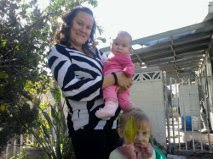Two disasters that could affect the Southern California region are Earthquakes and Fires. The preschool environment that I am going to create is in Anaheim, California with 2-year olds, and after school children ranging from ages 6-12. The dangers of an earthquake are devastating depending on the severity of the quake. In some instances, cupboards can open, large furniture can fall, and buildings can experience structural damage. Children can become victims of things and furniture falling on them if the objects are not properly strapped down. Also, some daycare centers have stoves in which meals are prepared. If the stove is not properly secured in place, it can pose a hazard to the children as well. Sudden jolting of the stove can create the stove to move around which can create the stove to separate from the gas valve which is dangerous because of gas leaks or an explosion can occur. The children are the most at risk from earthquakes because they are smaller and more susceptible to injury.
Fires are another extreme disaster that can cause risks to children and adults. Children can be harmed from fires due to burns, smoke inhalation, or objects collapsing on them. If there is a lot of brush and trees near the facility it needs to be clear from the building so the building cannot be harmed from fire. Children are the most at risk from fires because smoke inhalation can cause them lung damage or not to be able to breathe properly. A child has smaller lungs than an adult, so if there is a fire, it is important to stay close to the ground where the air quality is better.
Being prepared is very important because everyone can work together to come up with solutions if a disaster hits, and by making a preparedness kit, the children’s safety becomes enhanced. Being prepared can also teach the children that disasters can occur and they can learn to be prepared if the time comes. It helps to have both an earthquake and fire kit handy. The items that are important to have in these kinds of kits are food, blankets, water, contact numbers for emergency personnel and parents, flashlights, and bandages (“American Red Cross,” 2003). The consequences of not being prepared could be devastating. If the environment is not safe, death could be a result as well as injury. It is important to have the environment inspected yearly as a precaution to ensure the safety of the children. If furniture falls on the children they could be hurt badly. Lastly, if the environment is not safe, the risk is greater for children.
In developing a plan, the appropriate steps would need to be enforced: First, I would create a map for evacuation with all of the possible dangers to avoid or that need repair. Also, I would need to have a list of all of the children to take count in case a disaster shall occur. By making survival kits and having those easily accessible can help to make things easier in case a disaster occurs. Lastly, having access to the outside world via telephone, radio, or television is important to see what is expected next in terms of the disaster. The most important thing in any disaster is ensuring the safety of the children. If a disaster occurs I need to remain calm to protect the children. Also, I need to take the children to a safe zone and wait until help arrives or to see if it is ok to return to our normal activities. An evacuation technique that I have devised is to relocate the children to an open area such as the middle of the classroom or to walk to an outside or open area depending on the disaster. We can have the children sit together on the circle time rug until parents arrive to retrieve their child, or until medical personnel arrive to help. Lastly, I need to inform parents of the disaster and the condition of the children. This helps to have the parents be informed to reduce any chances of panic. Also, parents may be able to help out if needed, and they may be able to take their children home in case the environment gets too dangerous for them to be in or destroyed. Moreover, parents can get involved with helping the teacher and children to create the first aid kits. This is important for parents to be assured and informed that their children are prepared should a disaster occur.
Resources
American Red Cross. (2003, June). Retrieved March 21, 2010 from (www.redcross.org/www-
files/Documents/pdf/getting_assistance/pickingupthepieces_disaster.pdf). June,2003
Monday, April 12, 2010
Subscribe to:
Comments (Atom)
